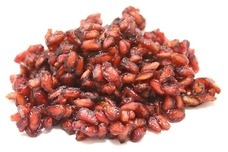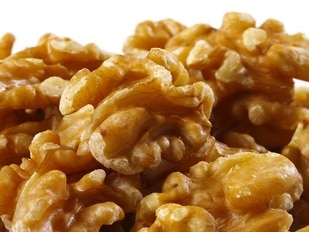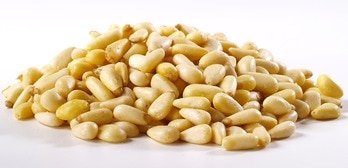Diabetes
Are you trying to prevent diabetes, lower your blood sugar levels, or just looking to understand the condition? Learn more about diabetes and check out this list of healthy snacks handpicked by our Health Nut and Registered Dietitian. Successfully managing diabetes is all about balancing blood sugar levels and maintaining or achieving a healthy weight.
What is Diabetes?
Diabetes (often referred to in the medical community as diabetes mellitus) is caused by the body's inability to produce any or enough insulin. Insulin is the hormone the converts sugar, a.k.a glucose, to energy. Without adequate levels of insulin, sugar accumulates in the bloodstream instead of being delivered to cells to use as energy. This glucose build-up leads to high blood sugar, which triggers the signs and symptoms of diabetes.
What is the Difference Between Type 1 and Type 2 Diabetes?
Type 1 diabetes (formerly known as juvenile diabetes) is characterized by a complete lack of insulin. This type of diabetes only accounts for about 5% of people who have diabetes, and is typically diagnosed in children and young adults. In Type 1 diabetes, the immune system destroys pancreatic cells that are required to produce insulin. Blood sugar levels rise without insulin to convert glucose to energy.
Type 2 diabetes (also referred to as adult-onset diabetes) is the most common form of diabetes. Affecting 95% of people with diabetes, type 2 is usually detected in adulthood, although children can also develop it. In Type 2 diabetes, the body does not effectively use insulin, a condition known as insulin resistance. Initially, the pancreas responds by making more insulin to compensate, but over time, it produces less and less. This results in insulin deficiency because the body can't make enough insulin to keep blood glucose levels in check.
Symptoms of Diabetes
People with diabetes may experience symptoms, however it’s important to remember that sometimes symptoms are so mild that they can go unnoticed. Hypoglycemia (low blood sugar) is a common diabetic condition that is associated with hunger, fatigue, anxiety and more. These symptoms occur because your body lacks insulin to deliver glucose to your cells. Without this glucose, your energy levels go down, causing hunger and tiredness. On the other hand, hyperglycemia (high blood sugar) is associated with more frequent urination and excessive thirst. When blood sugar levels are high, the body tries to get rid of excess glucose by urinating more frequently. This in turn, causes more thirst than normal.
Dry mouth and itchy skin are also common symptoms of diabetes because excess urination results in the body using more fluids, which leads to dehydration. The constant fluctuation of fluid levels in your body can also lead to blurred vision because it pulls moisture from the lenses of your eyes. If left untreated, diabetes can cause more serious vision problems, such as cataracts, glaucoma, and retinopathy. Diabetes also increases susceptibility to infections because of the disrupted environment of the immune system.
What are Normal Blood Glucose Levels?
The amount of glucose, a.k.a. sugar, in your blood is affected by different factors. It can fluctuate throughout the day depending on when, what and how much you last ate, your activity levels, and any diabetes medication you may be taking. In the U.S., blood glucose test results are reported as mg/dL (milligrams per deciliter). Here are the normal levels:
– A normal fasting* blood sugar level is between 70 and 99 mg/dL (*No food consumed in the past 8 hours).
– A normal blood sugar level two hours after eating is less than 140 mg/dL.
How is Diabetes Diagnosed?
Diabetes may be diagnosed by one of the following:
1) Fasting Blood Glucose Tests - Two consecutive tests that are higher than 126 mg/dL.
2) Random Blood Glucose Test - Any random test that reports levels higher than 200 mg/dL.
3) Oral Glucose Tolerance Test - A test that reports levels higher than 200 mg/dL after 8 hours of fasting, and 2 hours after drinking a special sugar drink.
Other Diabetic-Related Conditions:
Prediabetes:
Prediabetes is characterized by higher than normal blood glucose levels, although not as high as diabetes. This condition may be diagnosed if a fasting blood glucose test reports levels in between 100-125 mg/dL. People with prediabetes are at greater risk for developing type 2 diabetes. Lifestyle changes such as healthy eating, daily exercise, and weight loss can help bring blood sugar levels back down to normal levels.
Gestational diabetes:
This type of diabetes occurs in pregnant women who have high blood glucose levels during pregnancy, despite not having diabetes before. Although researchers are not sure what exactly causes some women to develop gestational diabetes, they have some clues. Hormones from the placenta that help the baby develop also impair the action of insulin, which raises blood sugar. Although it is normal to have slightly elevated levels of blood sugar at the time of pregnancy, it can be problematic for the mother and her baby if they become too high, which is why gestational diabetes should be carefully managed.
Monogenic diabetes:
Commonly misdiagnosed as type 1 or type 2 diabetes, monogenic diabetes is caused by a mutation in a single gene of the diabetic person. This condition is often referred to as MODY (maturity onset diabetes of the young). Over 20 genes have been linked to this type of diabetes, and a mutation in any of them can cause a child or adult to develop the condition.
Treatment and Management
1) Eat well and manage carbs
A healthy meal provides a combination of starches, proteins, vegetables and fruits, and fats. Carbohydrates can have a big impact on blood sugar levels, which is why it's important to monitor the amount of carbohydrates in your food. Choose whole grain versions of bread and rice, which do not raise blood sugar levels as drastically as more refined starches like white bread and white rice. Whole grain products also contain more fiber to help keep blood sugar levels stable.
2) Exercise regularly
Work with your doctor to find the right exercise plan for your lifestyle. Exercise is important for everyone, but especially for people with diabetes. When you exercise, your body becomes more sensitive to insulin so that your body can use it more efficiently. Additionally, exercise causes the muscles to contract and allows the cells to take up glucose and convert it to energy, regardless of whether insulin is present or not. Exercise also supports weight loss and sometimes losing weight to a healthy range can bring blood sugar levels back into check.
3) Talk to your doctor about other treatments and medications
If diet and exercise alone aren't enough to manage your diabetes, your doctor may recommend insulin or other diabetes medications. There are many options available, so it's important to talk to your doctor to find the type of medication that is right for you.
4) Keep your blood sugar levels in check
A blood glucose monitoring device can help you monitor your blood sugar levels on a day-to-day basis. Keeping a log of your numbers can help your physician understand how the prescribed diabetes treatment plan is working for you.
5) Schedule regular doctor visits
The ideal frequency of medical check-ups depends on various factors, such as how well you are managing your diabetes. It’s generally recommended that people with diabetes who receive insulin shots visit their doctor every 3-4 months. Those who receive medication or are managing their diabetes through diet and exercise should visit their doctor every 4-6 months.
Snack Options for Diabetes
Heart health is an important consideration when it comes to choosing healthier snacks to help balance blood sugar levels. Unfortunately, diabetes and heart disease risk go hand-in-hand. Superfoods like chia seeds can reduce food cravings, while providing a source of heart-friendly omega-3 fatty acids.
You will find a couple of different types of nuts on this healthy snack list because a 2008 study published in The Journal of Nutrition found that nut consumption was inversely associated with the risk of type 2 diabetes. For example, the relative risk of developing diabetes was reduced 27 percent in those who ate nuts five or more times per week compared with those who rarely or never ate nuts. That’s a pretty good reason to grab a few almonds before you head out of the house.
The options on our diabetes snack list have about 30 grams or less total carbohydrates and they have low sodium and saturated fat levels. A small handful of each snack is about an ounce worth. If you have two handfuls, that may be okay, but be sure to double the nutrition facts (calories, fat, etc.) to account for it properly in your daily meal planning!
This page is for informational purposes only and shouldn't replace medical advice.
Try some Diabetic Foods!
Healthy Eating
- Healthy Snacks
- Healthy Highlights
- 5 Uses for Cacao Powder
- 5 Ways to Eat Farro
- 6 Best Gluten-Free Foods
- Alcohol and the Body
- Almond Flour Recipes
- Anti-Aging Superfoods
- Beat the Afternoon Slump
- Benefits of a Plant-Based Diet
- Benefits of Baobab
- Benefits of Cashews
- Benefits of Coconut Oil for Hair
- Benefits of Coconuts
- Benefits of Dates
- Benefits of Fenugreek
- Benefits of Garcinia Cambogia
- Benefits of Goji Berries
- Benefits of Kale Chips
- Benefits of Monk Fruit Sweetener
- Benefits of Peanuts
- Benefits of Pecans
- Benefits of Pistachios
- Benefits of Pumpkin Seeds
- Benefits of Spelt Flour
- Benefits of Steel Cut Oats
- Benefits of Sunflower Seeds
- Benefits of Tiger Nuts
- Benefits of Turmeric
- Benefits of Walnuts
- Benefits of Wheatgrass
- Best Food Fads
- Cacao vs Cocoa
- Caffeine-Free Energy Foods
- Chocolate That's Good for You
- Diet vs. Exercise
- Fat Burning Foods
- Food Myths Debunked
- Foods for Bone Density
- Foods for Colon Health
- Foods for Healthy Hair
- Foods for Healthy Skin
- Foods to Help Sleep
- Foods to Reduce Stress
- Green Tea Benefits
- Healthy Baking Flours
- Heart Healthy Habits
- High Protein Health Risks
- How to Boost Your Metabolism
- How to Lose Weight While Aging
- How to Throw a Vegan BBQ
- Kaniwa vs Quinoa
- Little Health Foods
- Low-Carb: Fad or Friend?
- Making Healthier Desserts
- Mediterranean Diet Meal Plan
- Natural Beauty Products
- Nuts for Weight Loss
- Preparing Vegan Meals
- Preventing Muscle Degeneration
- Rare Superfoods
- Reduce Sugar Intake
- Save Time By Going Vegan
- Smarter Snack Swaps
- Smoothie Ingredients
- Soy Protein vs Whey Protein
- Starting a Plant-Based Diet
- Steel Cut vs Rolled Oats
- Sugar Substitutes
- Vegan Proteins
- Vegan Substitutions for Fall Recipes
- Why Go Vegan
- Healthy Meals
- Healthy Recipes
- Sports Nutrition
- Vitamins, Minerals & Nutrients










